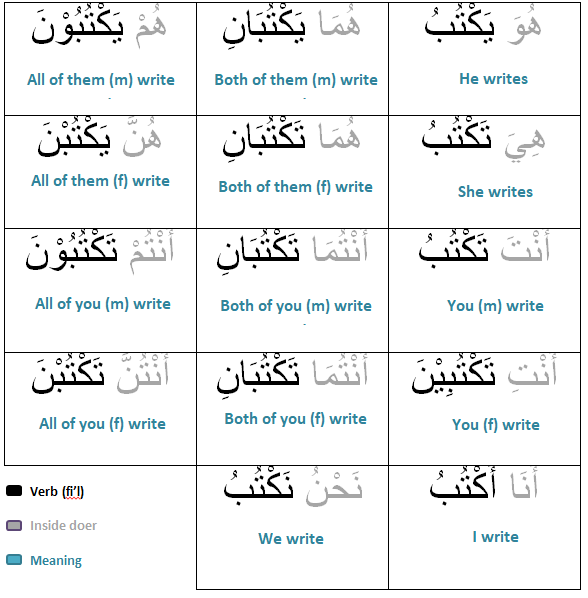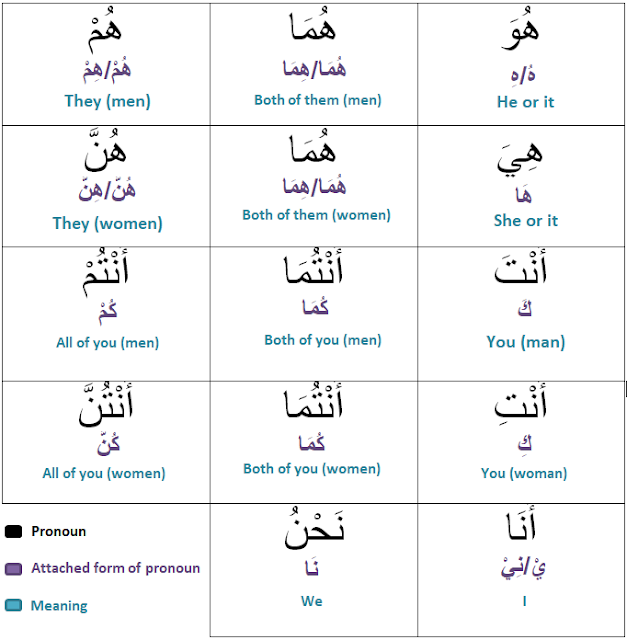Arabic present tense: practice 1
In the
present tense chart, none of the verbs have the ending sound of their pronouns.
But they have their own unique beginning and ending sounds. It would be easy
for us to remember this chart if we can identify those sounds. And as we can
see, many words begin with a ت.
Hence let’s take a look at the 5 kinds of ت
in this chart.
1. ت by itself – ‘you’ or ‘she’
2. ت with the ending sound AANI –
both of you
3. ت with the ending sound OONA – all of
you
4. ت with ending sound نَ
– all of you (f)
5. ت with the ending sound EENA –
you (f)
Mostly when
the pronoun is someone far away, it begins with a ي
except for the هِيَ and هُمَا
(f)
The verbs of
the last two pronouns begin with the beginning sound of their pronouns. Take a
look.
When you are
done memorizing this chart, try to recite the charts for the words given below.
Just try to recite at first. If you can recite the chart smoothly for all the
words, then think of the meanings of the verbs In Sha Allah.
يَنْصُرُ
(he helps)
يَشْرَبُ (he drinks)
يَفْهَمُ (he understands)
يَسْجُدُ (he makes sajda)
يَقْتُلُ (he kills)
*Lesson
inspired by a lesson of Arabic with Husna by Ustadh Nouman
************************************************************************
ފިޢްލް މާޟީގެ ތާވަލު ފަދައިން ފިޢްލް މުޟާރިޢް (ވޭވޭހުރިކަން)
ގެ މި ތާވަލުވެސް ހިތުދަސް ކުރުން ރަނގަޅީ ޟަމީރުތަކާއި އެކީގައެވެ. ތަކުރާރުކޮށް
ތާވަލު ކިޔާއިރު ހުވަ ޔަކްތުބު، ހުމާ ޔަކްތުބާނި، ހުމް ޔަކްތުބޫނަ މިފަދަ ގޮތަކަށް ކިޔާށެވެ. ދަސްކުރުމަށްޓަކައި ކިޔާއިރު
ބާރަށް ކިޔުމުން އަވަހަށް ހަނދާނުގައި ބަހައްޓަން ފަސޭހަވާނެއެވެ. ތާވަލު
ތަކުރާރުކޮށް ބަލައިގެން މަދުވެގެން ފަސް ފަހަރު ކިޔާށެވެ. އެއަށްފަހު ނުބަލައި
ކިޔޭތޯ މަސައްކަތް ކުރާށެވެ. އެހީތެރިއެއް ހުރިނަމަ ކުޑަކޮށް ފަރިތަކޮށްފައި އެ
އެހީތެރިޔާ ގާތު ޟަމީރުތައް ކިޔުމަށް އަންގާށެވެ. ކޮންމެ ޟަމީރަކަށް ފަހު ތިބާ
ފިޢްލް ކިޔާ ގޮތަށެވެ. މިސާލަކަށް އެހީތެރިޔާ ފުރަތަމަ ހުވަ ކިޔައިފިނަމަ ތިބާ
ކިޔާނީ ޔަކްތުބުއެވެ. ދެން އެހީތެރިޔާ ހުމާ ކިޔުމުން ތިބާ ކިޔާނީ ޔަކްތުބާނިއެވެ.
މިގޮތަށް ތާވަލު ކިޔުން 3 ފަހަރު ފުރިހަމަ ކުރުމަށްފަހު ތިބާ އަމިއްލައަށް
ޟަމީރުތަކާއެކީ ކިޔޭތޯ ބަލާށެވެ.
ފިޢްލް މާޟީގެ ތާވަލާއި ޚިލާފަށް ފިޢްލް މުޟާރިޢްގެ މި
ތާވަލުގައި އެއްވެސް ފިޢްލެއްގެ ނިމޭ އަޑު އެ ފިޢްލެއްގެ ޟަމީރާއި އެއްގޮތް
ނޫންކަން ތިބާއަށް ފާހަގަވާނެއެވެ. ކޮންމެ ފިޢްލެއްގައި ވަނީ ތަފާތު ފެށޭ އަޑަކާއި
ނިމޭ އަޑެކެވެ. އެ އަޑުތަކަށް އަހަރުމެން ފަރިތަވެއްޖެނަމަ މި ތާވަލު ދަސްކުރަން
ފަސޭހަވެގެންދާނެއެވެ. (އިން ޝާ ﷲ). އަހަރުމެންނަށް ފެންނާނެ ފަދައިން މި ތާވަލުގެ
ބައިވަރު ފިޢްލްތައް ފެށެނީ ت އިންނެވެ. އެހެންކަމުން މި ތާވަލުން ފެންނަ 5
ވައްތަރެއްގެ ت
އަށް ބަލާލަމާ ހިނގާށެވެ.
އެކަނި އޮންނަ ت – އެއީ 'ތިބާ' ނޫނީ
'އޭނަ (އ)' އެވެ.
'އާނި' އަޑާއެކީ އަންނަ ت – ތި ދެމީހުން
'އޫނަ' އަޑާއެކީ އަންނަ ت – ތި އެންމެން (ފ)
نَ އާއެކީ އަންނަ ت – ތި އެންމެން (އ)
'އީނަ' އަޑާއެކީ އެކީ އަންނަ ت – ތިބާ (އ)
މީގެ އިތުރުން ދުރުގައި ތިބޭ މީހުންނަށް ނިސްބަތްކުރެވޭ ޟަމީރުތައް
ޢާއްމުކޮށް ފެށޭނީ ي
އިންނެވެ. هِيَ އާއި هُمَا (އ) ފިޔަވައެވެ.
ތާވަލުގައިވާ އެންމެ ފަހު ދެ ފިޢްލްގެ އަޑަކީ އެ ފިޢްލްތަކުގެ ޟަމީރު ފެށޭ
އަޑެވެ. ތާވަލު ބައްލަވާލައްވާށެވެ.
ތާވަލު ހިތުދަސްކޮށް ނިމުމުން ތިރީގައި މިވާ ބަސްތައް މި
ތާވަލަށް ފައްތައިގެން ކިޔާށެވެ. ފުރަތަމަ ހަމައެކަނި ކިޔޭތޯ ބަލާށެވެ. ހުރިހާ
ބަހަކަށް އެއްވެސް ކުށެއްނެތި ތިބާއަށް ތާވަލު ކިޔޭނަމަ އެ ބަސްތަކުގެ މާނައާމެދު
ވިސްނާށެވެ. (އިން ޝާ ﷲ)
يَنْصُرُ (އޭނަ (ފ) އެހީވެއެވެ.)
يَشْرَبُ (އޭނަ (ފ) ބޮއެވެ.)
يَفْهَمُ (އޭނައަށް (ފ) ފަހުމްވެއެވެ.)
(އޭނަ (ފ) ސަޖިދަ ކުރެއެވެ.)
يَسْجُدُ
يَقْتُلُ (އޭނަ (ފ) ޤަތުލު ކުރެއެވެ.)




Present tense exercise (English):
ReplyDeletehttps://drive.google.com/file/d/19VSCNcow5gyaS_01QrQgcHvJsh1E_u3G/view
Present tense exercise answer key (English)
https://drive.google.com/file/d/1d3UriyQqxIZBaBUBw-PE6BkWjj2zd834/view
Present tense exercise (Dhivehi):
ReplyDeletehttps://drive.google.com/file/d/10fXlUmwwPs-1WEbBAO4aJLpjTSBQd8wS/view?usp=sharing
Present tense exercise answer key (Dhivehi):
https://drive.google.com/file/d/1eGEILREfGcPTjCUs9oJ_G_31MGyzMILI/view?usp=sharing